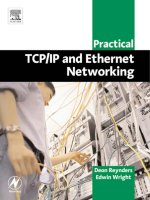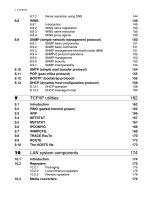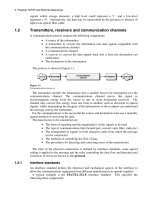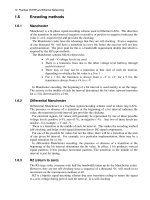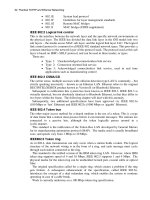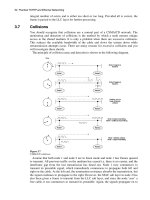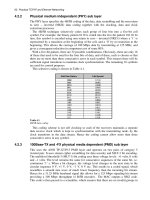Practical TCP/IP and Ethernet Networking- P18 doc
Bạn đang xem bản rút gọn của tài liệu. Xem và tải ngay bản đầy đủ của tài liệu tại đây (163.91 KB, 10 trang )
152 Practical TCP/IP and Ethernet Networking
object that contains a single object instance, the integer value that indicates the total
number of input Novell Netware packets on a router interface. An object identifier (or
object ID) uniquely identifies a managed object in the MIB hierarchy. The MIB hierarchy
can be depicted as a tree with a nameless root, the levels of which are assigned by
different organizations.
Figure 8.9
MIB tree
The top-level MIB object Ids belong to different standards organizations, while lower-
level object Ids are allocated by associated organizations. Vendors can define private
branches that include managed objects for their own products. MIBs that have not been
standardized typically are positioned in the experimental branch. The managed object at
Input can be uniquely identified either by the object name – iso.identified-organization.
dod.internet. private.enterprise.cisco.temporary variables.Novell.atInput – or by the
equivalent object descriptor: 1.3.6.1.4.1.9.3.4.1.
8.9.4 SNMPv2 protocol operations
SNMP is a simple request–response protocol. The network-management system issues a
request, and managed devices return responses. This behavior is implemented by using
one of four protocol operations: Get, GetNext, Set, and Trap:
• The Get operation is used by the NMS to retrieve the value of one or more
object instances from an agent. If the agent responding to the Get operation
Application layer protocols 153
cannot provide values for all the object instances in a list, it does not provide
any values
• The GetNext operation is used by the NMS to retrieve the value of the next
object instance in a table or list within an agent
• The Set operation is used by the NMS to set the values of object instances
within an agent
• The Trap operation is used by agents to asynchronously inform the NMS of
a significant event
The Get, GetNext, and Set operations used in SNMPv2 are exactly the same as that
used in SNMPv1. SNMPv2, however, adds and enhances some operations. The SNMPv2
Trap operation, for example, serves the same function as that used in SNMPv1. It,
however, uses a different message format and is designed to replace the SNMPv1 Trap.
SNMPv2 also defines two additional protocol operations: GetBulk and Inform:
• The GetBulk operation is used by the NMS to efficiently retrieve large
blocks of data, such as multiple rows in a table. GetBulk fills a response
message with as much of the requested data as will fit
• The Inform operation allows one NMS to send trap information to another
NMS and receive a response. In SNMPv2, if the agent responding to
GetBulk operations cannot provide values for all the variables in a list, it
provides partial results
8.9.5 SNMP management
SNMP is a distributed-management protocol. A system can operate exclusively as either
an NMS or an agent, or it can perform the functions of both. When a system operates as
both an NMS and an agent, another NMS might require that the system query managed
devices and provide a summary of the information learned, or that it report locally stored
management information.
8.9.6 SNMP security
SNMP lacks any authentication capabilities, which results in vulnerability to a variety of
security threats.
These include masquerading, modification of information, message sequence and
timing modifications, and disclosure:
• Masquerading consists of an unauthorized entity attempting to perform
management operations by assuming the identity of an authorized
management entity
• Modification of information involves an unauthorized entity attempting to
alter a message generated by an authorized entity so that the message results
in unauthorized accounting management or configuration management
operations
• Message sequence and timing modifications occur when an unauthorized
entity reorders, delays, or copies and later replays a message generated by an
authorized entity
• Disclosure results when an unauthorized entity extracts values stored in
managed objects, or learns of notifiable events by monitoring exchanges
between managers and agents
154 Practical TCP/IP and Ethernet Networking
Because SNMP does not implement authentication, many vendors do not implement
Set operations, thereby reducing SNMP to a monitoring facility.
8.9.7 SNMP interoperability
SNMPv2 is incompatible with SNMPv1 in two areas: message formats and protocol
operations. SNMPv2 messages use different header and protocol data unit (PDU)
formats than SNMPv1 messages. SNMPv2 also uses two protocol operations that are not
specified in SNMPv1. Furthermore, RFC 1908 defines two possible SNMPv1/v2
coexistence strategies: proxy agents and ‘bilingual’ network-management systems.
Proxy agents
An SNMPv2 agent can act as a proxy agent on behalf of SNMPv1 managed devices,
as follows:
• An SNMPv2 NMS issues a command intended for an SNMPv1 agent
• The NMS sends the SNMP message to the SNMPv2 proxy agent
• The proxy agent forwards Get, GetNext, and Set messages to the SNMPv1
agent unchanged
• GetBulk messages are converted by the proxy agent to GetNext messages
and then are forwarded to the SNMPv1 agent
• The proxy agent maps SNMPv1 Trap messages to SNMPv2 Trap messages
and then forwards them to the NMS
Bilingual network-management system
Bilingual SNMPv2 network-management systems support both SNMPv1 and SNMPv2.
To support this dual-management environment, a management application in the bilingual
NMS must contact an agent. The NMS then examines information stored in a local
database to determine whether the agent supports SNMPv1 or SNMPv2. Based on the
information in the database, the NMS communicates with the agent using the appropriate
version of SNMP.
8.10 SMTP (simple mail transfer protocol)
TCP/IP defines an electronic messaging protocol named SMTP. SMTP is used by E-mail
programs such as Outlook Express or Eudora to send E-mail messages and files from a
user on a local network to a user on a remote network.
SMTP defines the interchange between two SMTP processes. It does NOT define how
the mail is to be passed from the sender to SMTP, or how the mail is to be passed from
SMTP to the recipient. The SMTP process with mail to send is called the SMTP client,
while the receiving SMTP process is called the SMTP server.
Mail is forwarded to an SMTP client in one of two ways. The user can either use
TELNET to enter the information manually, or the application such as Outlook Express
can invoke the client.
The first step in the transmission of the data is the connection setup, whereby the SMTP
client opens a TCP connection to the remote SMTP server at port 25. The client then
sends a ‘Hello’ command containing the name of the sending user. The SMTP server now
sends a reply indicating its ability to receive mail. TELNET users will have to enter the IP
address or the domain name of the server (e.g. smtp-01.ny.us.ibm.net), the relevant port
number (25) and a terminal type (e.g. VT-100). The first two items are necessary for TCP
to create the necessary socket.
Application layer protocols 155
The second step in the process involves the actual mail transfer. Mail transfer begins
with a ‘Mail From’ command containing the name of the sender, followed by a ‘Receipt’
command indicating the recipient. A ‘Data’ command is followed by the actual message.
SMTP can be considered a reliable delivery service in that the underlying TCP protocol
ensures correct delivery to the SMTP server. SMTP, however, does not guarantee nor
offer mechanisms for reliable delivery from the SMTP server to the user.
When the message transfer is complete another message can be sent, the direction of
transfer changed, or the connection closed.
Closing the connection, involves the SMTP client issuing a ‘Quit’ command. Both sides
then execute a TCP close operation in order to release the connection.
SMTP commands begin with a four-octet command code (in ASCII), which can be
followed by an argument. The SMTP replies use the same format as FTP, i.e. a 3-digit
numeric value followed by a text string. Here follows some SMTP commands.
HELO
MAIL FROM: sender-e-mail-address
VRFY recipient-mail-address
RCPT TO: recipient-e-mail-address
EXPN alias-name
DATA
HELP command-name
RSET
NOOP
QUIT
In the following example a simple ASCII string is sent to a recipient via a TELNET
connection.
220 prserv.net – Maillenium ESMTP/ MULTIBOX out4 #30
MAIL FROM:
250 ok
RCPT TO:
250 ok; forward to <)
DATA
354 ok
‘This is only a test message.’
.
250 ok, id = 2000042800030723903cb80fe
QUIT
8.11 POP (post office protocol)
The current version of the post office protocol is POP3. POP3 uses the well known port
number 110. Like SMTP, it involves a client running on a local machine and a server
running on a remote machine. POP3 is very much the opposite of SMTP in that its
function is to retrieve mail from a remote POP3 server to a local POP3 client.
It was developed to ease the load on mail servers. Instead of multiple clients logging in
to a remote mail server, the remote POP3 server makes a quick connection to the actual
mail server, retrieves and removes the mail from the mail server, and then downloads it to
the local POP3 client. As in the case of SMTP, it uses a TCP connection for this purpose.
Unlike SMTP, proper authentication with a user name and a password is required.
POP3 commands include the following.
STAT
156 Practical TCP/IP and Ethernet Networking
LIST message-number
RETR message-number
DELE message-number
NOOP
RSET
QUIT
TOP message-number number-of-lines
The following example shows the interaction with a POP3 server via a
TELNET connection.
+OK POP Server Version 1.0 at pop1a.prserv.net
USER auinet.deb
+OK Password required for deb
PASS geronimo
+OK deb has 2 messages (750 octets)_
LIST
+OK 2 messages (75 octets)
1 374
2 376
TOP 1 10
+OK 274 octets
Received from out4.prserv.net [32.97.166.34] by in2.prserv.net id 956880005.59882-1:
Fri, 28 Apr 2000- 00:00:00 +0000
Received: from <unknown domain> ([129:37:1675:208] by prserv.net (out4) with
SMTP
Id <2000042723591123901fj001e; Thu, 27 Apr 2000 23:59:48: +0000
‘This is only a test message.’
QUIT
8.12 BOOTP (bootstrap protocol)
The bootstrap protocol BOOTP (RFC 951) is an alternative to RARP. When a diskless
workstation (for example a PLC) is powered up, it broadcasts a BOOTP request on the
network.
A BOOTP server hears the request, looks up the requesting client’s MAC address in its
BOOTP file, and responds by telling the requesting client machine:
• The server’s IP address and NetBIOS name
• The fully qualified name of the file that is to be loaded into memory of the
requesting machine, and executed at boot-up
Although BOOTP is an alternative to RARP, it operates in an entirely different way.
RARP operates at the data link layer and the RARP packets are contained within the local
network (e.g. Ethernet) frames; hence it cannot cross any routers. With BOOTP the
information is carried by UDP via IP, hence it can operate on an internetwork across
routers and the server can be several hops away from the client and facilitate address
resolution across routers. Although BOOTP uses IP and UDP, it is still small enough to
fit within a bootstrap ROM on a client workstation.
Figure 8.10 depicts the BOOTP message format.
Application layer protocols 157
Figure 8.10
BootP frame
• Op: 8 bits
The message type, 1 = BOOTREQUEST, 2 = BOOTREPLY
• Htype: 8 bits
Same as for ARP/RARP
• Hlen: 8 bits
Same as for ARP/RARP
• Hops: 8 bits
Used by relay agents when booting via a relay agent. A client sets this field
to 0.
• Transaction ID: 32 bits
(Also called XID). A random tracking number as for the IP and ICMP
protocols
• Seconds: 16 bits
The seconds elapsed since the client started to boot
• Client IP address: 32 bits
Set by the client to its IP address, or initially to zero
• Your IP address: 32 bits
Set by the server to the correct IP address for the client, if the client
advertises its IP address as 0
• Server IP address: 32 bits
Server IP address, set by the server
• Gateway IP address: 32 bits
The Gateway (router) address, set by the relay agent
• Client hardware address: 16 bytes
The client MAC address, set by itself
• Server host name: 64 bytes
An optional server name, e.g. Garfield or Computer10
• Boot file name: 128 bytes
Used by the server to return a fully qualified directory path name to the
158 Practical TCP/IP and Ethernet Networking
client, e.g. c:\windows\bootfiles\startup.exe. This is the location on the
server from which the boot file has to be downloaded
• Vendor-specific area: 64 bytes
DHCP options as per RFC 1531
RFC 1532 and RFC 1533 contain subsequent clarifications and extensions to BOOTP.
8.13 DHCP (dynamic host configuration protocol)
DHCP, as defined by RFC 1533, 1534, 1541, and 1542 was developed out of BOOTP in
an effort to centralize and streamline the allocation of IP addresses. DHCP’s purpose is
to centrally control IP-related information and eliminate the need to manually keep track
of where individual IP addresses are allocated.
When TCP/IP starts up on a DHCP-enabled host, a special message is sent out
requesting an IP address and a subnet mask from a DHCP server. The contacted server
checks its internal database, then replies with an offer message comprising the
information the client requested. DHCP can also respond with a default gateway address,
DNS address(es), or a NetBIOS name server, such as WINS. When the IP offer is
accepted, it is then extended to the client for a specified period of time, called a lease. If
the DHCP server runs out of IP addresses, no IP addressing information can be offered to
the clients, causing TCP/IP initialization to fail.
DHCP’s advantages include the following:
It’s inexpensive. The server software comes built into many operating systems, and the
manual effort involved in managing large numbers of IP addresses is reduced.
IP configuration information is entered electronically by another system, eliminating
the possibility of human error.
IP becomes a ‘plug and play operation’.
It does, however, have some drawbacks such as:
A new user may randomly (delinquently!) enter a fixed IP address on his computer in
order to gain immediate access to the network. Later, that number may be assigned by
DHCP to a different user and show up as a duplicate.
Because the initial input for IP addresses, subnet masks, gateways, DNS addresses, and
NetBIOS name server address is done by a human on a PC, it can easily be
entered incorrectly.
Exclusive reliance on the DHCP server during the TCP/IP initialization phase could
result in an initialization failure if that server is down, or otherwise unavailable.
Certain applications of TCP/IP, like logging in to a remote network through a firewall,
require the use of a specific IP address. DHCP allows for exclusions that prevent certain
IP address ranges from being used. If the specific IP address that is needed for remote
login has been excluded, the user has a problem.
There is an extensive amount of incredibly tedious work involved in maintaining an
accurate roster of both used and free IP addresses.
8.13.1 DHCP operation
IP lease request
This is the first step in obtaining an IP address under DHCP. It is initiated by a host with
TCP/IP, configured to obtain an IP address automatically, if booted up. Since the
requesting client is not aware of its own IP address, or that belonging to the DHCP server,
it will use 0.0.0.0 and 255.255.255.255, respectively. This is known as a DHCP discover
Application layer protocols 159
message. The broadcast is created with UDP ports 67 (BOOTP client) and 68 (BOOTP
server). This message contains the MAC address and NetBIOS name for the client
system to be used in the next phase of sending a lease offer. If no DHCP server responds
to the initial broadcast, the request is repeated three more times at 9, 13, and 16-second
intervals, plus a random event occurring in the period between 0 and 1000 milliseconds.
If still no response is received, a broadcast message is made every five minutes until it is
finally answered. If no DHCP server ever becomes available, no TCP/IP
communications will be possible.
IP lease offer
The second phase involves the actual information given by all DHCP servers that have
valid addressing information to offer. Their offers consist of an IP address, subnet mask,
lease period (in seconds), and the IP address of the proposing DHCP server. These offers
are sent to the requesting client’s MAC address. The pending IP address offer is reserved
temporarily to prevent it from being taken simultaneously by other machines, which
would otherwise create chaos. Since multiple DHCP servers can be configured, it also
adds a degree of fault tolerance, should one of the DHCP servers go down.
IP lease selection
During this phase, the client machine selects the first IP address offer it receives. The
client replies by broadcasting an acceptance message, requesting to lease IP information.
Just as in stage one, this message will be broadcast as a DHCP request, but this time, it
will additionally include the IP address of the DHCP server whose offer was accepted.
All other DHCP servers will then revoke their offers.
IP lease acknowledgment
The accepted DHCP server proceeds to assign an IP address to the client, then sends an
acknowledgement message, called a DHCPACK, back to the client. Occasionally, a
negative acknowledgment, called a DHCPNACK, is returned. This type of message is
most often generated if the client is attempting to lease its old IP address, which has since
been reassigned elsewhere. Negative acceptance messages can also mean that the
requesting client has an inaccurate IP address, resulting from physically changing
locations to an alternate subnet.
After this final phase has been successfully completed, the client machine integrates the
new IP information into its TCP/IP configuration. It is then usable with all utilities, as if it
has been manually entered into the client host.
Lease renewal:
Regardless of the length of time an IP address is leased, the leasing client will send a
DHCPREQUEST to the DHCP server when its lease period has elapsed by 50%. If the
DHCP server is available, and there are no reasons for rejecting the request, a DHCP
acknowledge message is sent to the client, updating the configuration and resetting the
lease time. If the server is unavailable, the client will receive an ‘eviction’ notice stating
that it had not been renewed. In this event, that client would still have a remaining 50%
lease time, and would be allowed full usage privileges for its duration. The rejected client
would react by sending out an additional lease renewal attempt when 87.5% of its lease
time had elapsed. Any available DHCP server could respond to this DHCPREQUEST
message with a DHCPACK, and renew the lease. However, if the client received a
DHCPNACK (negative) message, it would have to stop using the IP address
immediately, and start the leasing process over, from the beginning.
160 Practical TCP/IP and Ethernet Networking
Lease release
If the client elects to cancel the lease, or is unable to contact the DHCP server before the
lease elapses, the lease is automatically released.
Note that DHCP leases are not automatically released at system shutdown. A system
that has lost its lease will attempt to re-lease the same address that it had
previously used.
8.13.2 DHCP message format
The DHCP message format is based on the BOOTP format, and is illustrated
in Fig 8.11.
Figure 8.11
DHCP message format
The fields are as follows:
• Op: 8 bits
The message type, 1 = BOOTREQUEST, 2 = BOOTREPLY
• Htype: 8 bits
Same as for ARP/RARP
• Hlen: 8 bits
Same as for ARP/RARP
• Hops: 8 bits
Used by relay agents when booting via a relay agent. A client sets this field
to 0
• Transaction ID: 32 bits
(Also called XID). A random tracking number as for the IP and ICMP
protocols
• Seconds: 16 bits
The seconds elapsed since the client started to boot
• Flags: 16 bits
This field contains a 1-bit broadcast flag, as described in RFC 1531
• Client IP address (ciaddr): 32 bits
Set by the client to its IP address, or initially to zero
Application layer protocols 161
• Your IP address (yiaddr): 32 bits
Set by the server to the correct IP address for the client, if the client
advertises its IP address as 0
• Server IP address (siaddr): 32 bits
Server IP address, set by the server
• Gateway IP address (giaddr): 32 bits
The gateway (router) address, set by the relay agent
• Client hardware address (chaddr): 16 bytes
The clients MAC address set by itself
• Server name (sname): 64 bytes
An optional server name, e.g. Garfield or Computer10
• Boot file name: 128 bytes
Used by the server to return a fully qualified directory path name to the
client, e.g. c:\windows\bootfiles\startup.exe. This is the location on the
server from which the boot file has to be downloaded
•
Options: Up to 312 bytes
DHCP options as per RFC 1531
